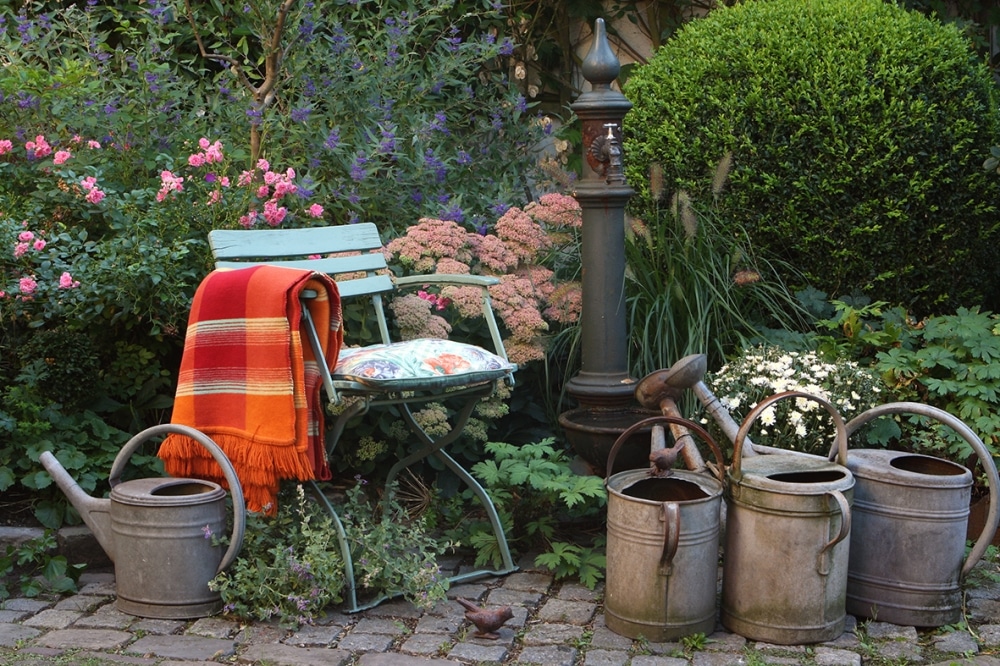As well as vibrant bursts of colour and interesting textures, a sensory garden also needs to smell great. Here are my picks of the best fragrant flowers around . . .
Buddleja davidii ‘Santana’
Known as the butterfly bush, buddleja davidii bears conical, nectar-rich flowers which attract butterflies and bees in late summer. Their flowers come in a variety of colours including purple, blue, pink and white. Buddleja is easy to grow and thrives in almost any situation. Buddleja davidii ‘Santana’ has unusual, lance-shaped variegated leaves, and bears wine-red flowers from July to September. To encourage later flowering (which benefits garden butterflies such as the small tortoiseshell), cut plants back to the base in May. Buddleja ‘Santana’ is known for attracting bees, birds, butterflies, moths and other pollinators. Its nectar and pollen-rich-flowers provide shelter and habitat. It has seeds for birds and is also a caterpillar food plant.
Salvia guaranitica ‘Blue Enigma’
‘Blue Enigma’ is a tall perennial with ovate leaves and axillary spikes of deep blue, two-lipped flowers which grow up to 5cm in length and flourish in late summer and autumn. The foliage of salvia guaranitica has a pleasant anise aroma to it, hence the common name anise-scented sage. Give it a warm, sunny spot and grow in well-drained soil.
Heptacodium miconioides
Related to honeysuckle, it’s no surprise that heptacodium miconioides packs a scent-filled punch. Pretty white flowers in September are followed by rosy-pink calyces. Extremely hardy and a great tree for shade. Clusters of scented, creamy-white flowers appear at the ends of the branches from late summer, and long after they have fallen, the pinkish-red calyxes often remain colourful, deepening to rich burgundy as they age.
When not in flower the deciduous leaves are attractive in their own right. Lustrous green and deeply veined, they hang in elegant pairs along the branches, usually becoming tinged with claret before they fall. As a member of the honeysuckle family, this multi-stemmed shrub or small tree is loved by butterflies and makes a stylish and unusual addition to the garden.
Phlox paniculata
These cottage garden favourites are revered for their sweet, honey-like fragrance. Phlox is enjoyed by butterflies and bees too, and there are many garden-worthy cultivars available in a range of heights and with different coloured flowers, making them a popular stalwart of the traditional border. Don’t forget to cut some flower heads and pop in a vase, so you can enjoy the scent indoors.
Monarda didyma ‘Fireball’
This particular variety bears incredible deep scarlet blooms over compact clumps of foliage. Resistant to mildew, it’s a fine choice for a mixed herbaceous border or wildlife garden. Monarda didyma, or bergamot, has distinctive flowerheads; each one consists of a large number of curving tubular flowers growing out from a central point, creating a shaggy dome of petals. It has a long flowering season, from early summer to early autumn, and blooms almost continuously if deadheaded regularly. Bergamot foliage is aromatic, and leaves are sometimes picked for pot-pourri. In moist soils bergamot can spread fairly quickly so clumps may need to be divided about every three years. Its flowers are extremely attractive
to bees.
For more information on Victoria Truman visit www.victoriatruman.com
How to weed out the Vine Weevil
This summer I have noticed more vine weevil attacks so to save the plants in your garden from being attacked and eaten by them please read this advice, which has been provided by the Royal Horticultural Society:
Vine weevil
Vine weevil is a widespread insect in Britain. Gardeners with vine weevil should keep up their guard because stopping control measures after the apparent disappearance of the weevil can allow numbers to build up again.
Non-pesticide control
On mild evenings inspect plants and walls by torchlight and pick off the adult weevils. Shake shrubs over an upturned umbrella, newspaper or similar to dislodge and collect more. In greenhouses, look under pots or on the underside of staging benches where the beetles hide during the day.
Trap adults with sticky barriers placed around pots or on greenhouse staging to encourage natural enemies. Vine weevils and their grubs are eaten by a variety of predators such as birds, frogs, toads, shrews, hedgehogs and predatory ground and rove beetles. Remove as many larvae as possible from compost infested with grubs.
Biological control
A biological control for the larvae is available as a microscopic insect pathogenic nematode. This is suitable for use in containers and in the open ground. For best results apply in early September (if you have not already done so) when the soil temperature or potting medium is warm enough for the nematode to be effective (5-20C/41-68F) and before the vine weevil grubs have grown large enough to cause serious damage. The nematode heterorhabditis megidis is also available for larvae but it
is more temperature dependent (12-20C/ 54-68F).
The nematodes (or roundworms) can give poor results in dry or heavy soils. They work best in lighter soils and open potting composts such as peat or coir. Nematodes can be used safely on all edible and ornamental plants.
A trap containing nematodes is available for keeping adult vine weevil under control. The traps should be placed on the ground below plants damaged by the weevils during the summer. The adults enter the trap during the day and are infected by the nematodes.
For more information visit www.rhs.org.uk/advice








